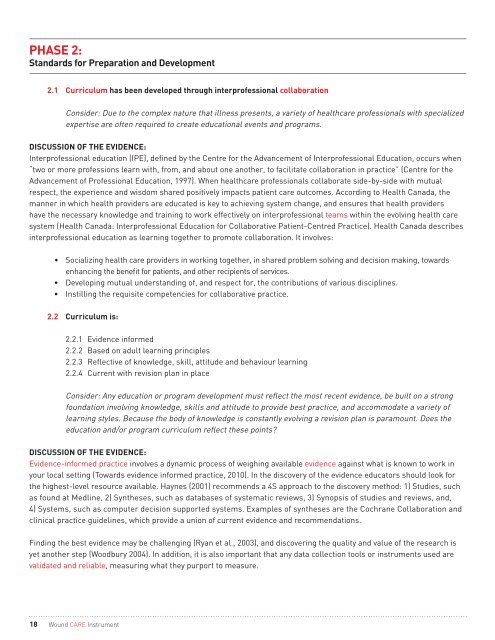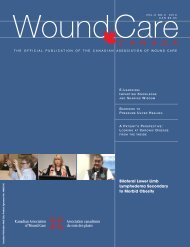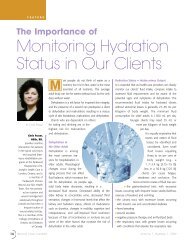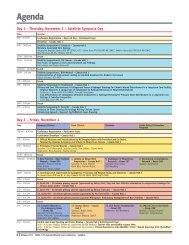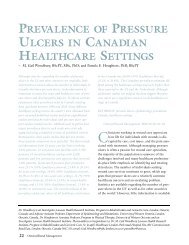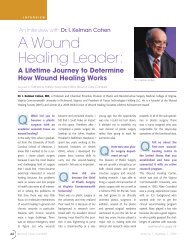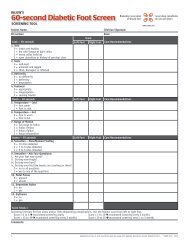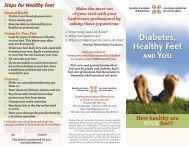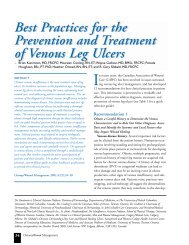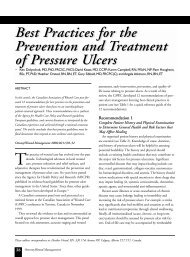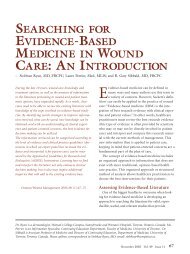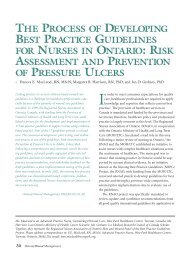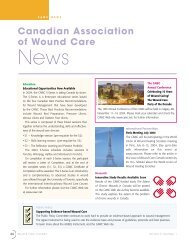Wound Care Instrument - Canadian Association of Wound Care
Wound Care Instrument - Canadian Association of Wound Care
Wound Care Instrument - Canadian Association of Wound Care
You also want an ePaper? Increase the reach of your titles
YUMPU automatically turns print PDFs into web optimized ePapers that Google loves.
phase 2:<br />
standards for preparation and Development<br />
2.1 Curriculum has been developed through interpr<strong>of</strong>essional collaboration<br />
Consider: Due to the complex nature that illness presents, a variety <strong>of</strong> healthcare pr<strong>of</strong>essionals with specialized<br />
expertise are <strong>of</strong>ten required to create educational events and programs.<br />
DisCUssioN <strong>of</strong> the eviDeNCe:<br />
Interpr<strong>of</strong>essional education (IPE), defined by the Centre for the Advancement <strong>of</strong> Interpr<strong>of</strong>essional Education, occurs when<br />
“two or more pr<strong>of</strong>essions learn with, from, and about one another, to facilitate collaboration in practice” (Centre for the<br />
Advancement <strong>of</strong> Pr<strong>of</strong>essional Education, 1997). When healthcare pr<strong>of</strong>essionals collaborate side-by-side with mutual<br />
respect, the experience and wisdom shared positively impacts patient care outcomes. According to Health Canada, the<br />
manner in which health providers are educated is key to achieving system change, and ensures that health providers<br />
have the necessary knowledge and training to work effectively on interpr<strong>of</strong>essional teams within the evolving health care<br />
system (Health Canada: Interpr<strong>of</strong>essional Education for Collaborative Patient-Centred Practice). Health Canada describes<br />
interpr<strong>of</strong>essional education as learning together to promote collaboration. It involves:<br />
• Socializing health care providers in working together, in shared problem solving and decision making, towards<br />
enhancing the benefit for patients, and other recipients <strong>of</strong> services.<br />
• Developing mutual understanding <strong>of</strong>, and respect for, the contributions <strong>of</strong> various disciplines.<br />
• Instilling the requisite competencies for collaborative practice.<br />
2.2 Curriculum is:<br />
2.2.1 Evidence informed<br />
2.2.2 Based on adult learning principles<br />
2.2.3 Reflective <strong>of</strong> knowledge, skill, attitude and behaviour learning<br />
2.2.4 Current with revision plan in place<br />
Consider: Any education or program development must reflect the most recent evidence, be built on a strong<br />
foundation involving knowledge, skills and attitude to provide best practice, and accommodate a variety <strong>of</strong><br />
learning styles. Because the body <strong>of</strong> knowledge is constantly evolving a revision plan is paramount. Does the<br />
education and/or program curriculum reflect these points?<br />
DisCUssioN <strong>of</strong> the eviDeNCe:<br />
Evidence-informed practice involves a dynamic process <strong>of</strong> weighing available evidence against what is known to work in<br />
your local setting (Towards evidence informed practice, 2010). In the discovery <strong>of</strong> the evidence educators should look for<br />
the highest-level resource available. Haynes (2001) recommends a 4S approach to the discovery method: 1) Studies, such<br />
as found at Medline, 2) Syntheses, such as databases <strong>of</strong> systematic reviews, 3) Synopsis <strong>of</strong> studies and reviews, and,<br />
4) Systems, such as computer decision supported systems. Examples <strong>of</strong> syntheses are the Cochrane Collaboration and<br />
clinical practice guidelines, which provide a union <strong>of</strong> current evidence and recommendations.<br />
Finding the best evidence may be challenging (Ryan et al., 2003), and discovering the quality and value <strong>of</strong> the research is<br />
yet another step (Woodbury 2004). In addition, it is also important that any data collection tools or instruments used are<br />
validated and reliable, measuring what they purport to measure.<br />
18 <strong>Wound</strong> CARE <strong>Instrument</strong>


